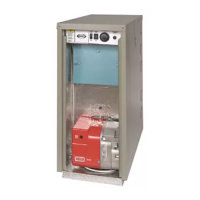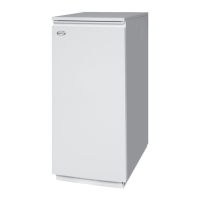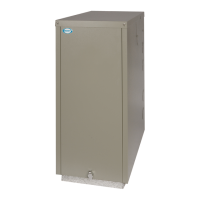34
Grant Vortex External Module
9 - BOILER SERVICING
To ensure efficient operation of the boiler it is
recommended that it is checked and serviced as necessary
at regular intervals. The frequency of servicing will
depend upon the particular installation conditions and
usage, but in general once per year should be adequate.
Servicing and replacement of parts must only be
carried out by a suitably qualified engineer.
Important: Details of every service should be entered
in the boiler passport. This information may be
required to validate the Grant extended warranty.
IMPORTANT
Before starting any work on the boiler, or fuel supply
please read the health and safety information given in
Section 14 on page 43.
Note: A test switch is fitted to the control panel to
allow the boiler to be test-fired. When On, the
switch by-passes the external control system.
1 Check the flue terminal and ensure it is not blocked
or damaged.
2 Run the boiler and check the operation of its controls.
3 Ensure that all water/fuel system connections and
fittings are sound. Remake any joints and check the
tightness of any fittings that may be leaking.
If the boiler is used on a sealed central heating
system, check the system pressure, check the
operation of the pressure relief valve and check the
expansion vessel air charge. See Section 6.6.
Refill, vent and re-pressurise the system as
necessary. See Section 6.9.
4 Check that the louvres in the front panel are clear.
5 Remove any sludge/water from the fuel tank by
opening the sludge valve at the lower end of the tank.
6 With the fuel supply valve closed, clean/replace the
filter element and clean the filter bowl.
7 Flexible fuel supply hoses should be inspected
annually when the boiler is serviced and braided
hoses replaced every year. If in doubt replace the
hoses.
Warning: Before servicing, set the boiler On/Off
switch to Off, isolate the electricity supply and close
the fuel supply valve. Allow the boiler to cool.
The data label on the inside of the case side panel will
indicate the nozzle fitted.
1 Remove the front panel by turning the handle and
withdrawing it forwards at the bottom.
2 Remove the four screws securing the top panel and
carefully lift it off, taking care not to damage the
insulation.
Note: The top panel has been designed to provide
a slight fall away from the side positioned against a
wall, the side of the top panel with the fixing
screws closer to the bottom edge is the highest side
and goes against the wall.
3 Remove the burner fixing nut (top of mounting
flange) and withdraw the burner.
If required, disconnect the flexible oil hose(s), use
a suitable container to prevent any oil spillage.
Note: If two flexible hoses are connected to the
burner, identify (mark if necessary) which is the
inlet and return if they are to be disconnected.
1 Remove the nuts and washers securing the front
cleaning door and withdraw the door. Take care - it
is heavy.
2 Remove the baffles as shown in Fig. 24, 25, 26 or
27.
3 Remove all deposits from the baffle plates and all
the boiler internal surfaces using a stiff brush and
scraper if necessary.
4 Check the condition of the flue, clean as necessary.
5 Check the condition of the front cleaning door seal,
replace if necessary.
6 Replace the baffles, ensuring they are correctly
fitted. See Fig. 24, 25, 26 or 27.
Note: 50/70 - Ensure that the front handle on the
top baffle (No. 4) is correctly located over the front
section of baffle No. 3.
7 Pull out the spiral turbulators from the heat exchanger
tubes. See Fig. 28.
Clean the turbulators using a stiff brush
Test the heat exchanger condensate drain by
pouring water into one of the lower tubes and
observe whether the water dicharges from the
22mm condensate outlet. Replace the turbulators.
IMPORTANT: When replacing the turbulators
ensure that the flat end sections are all positioned
vertically.
Important notes prior to servicing
9.1
Dismantling prior to servicing
9.2
Cleaning the boiler
9.3
